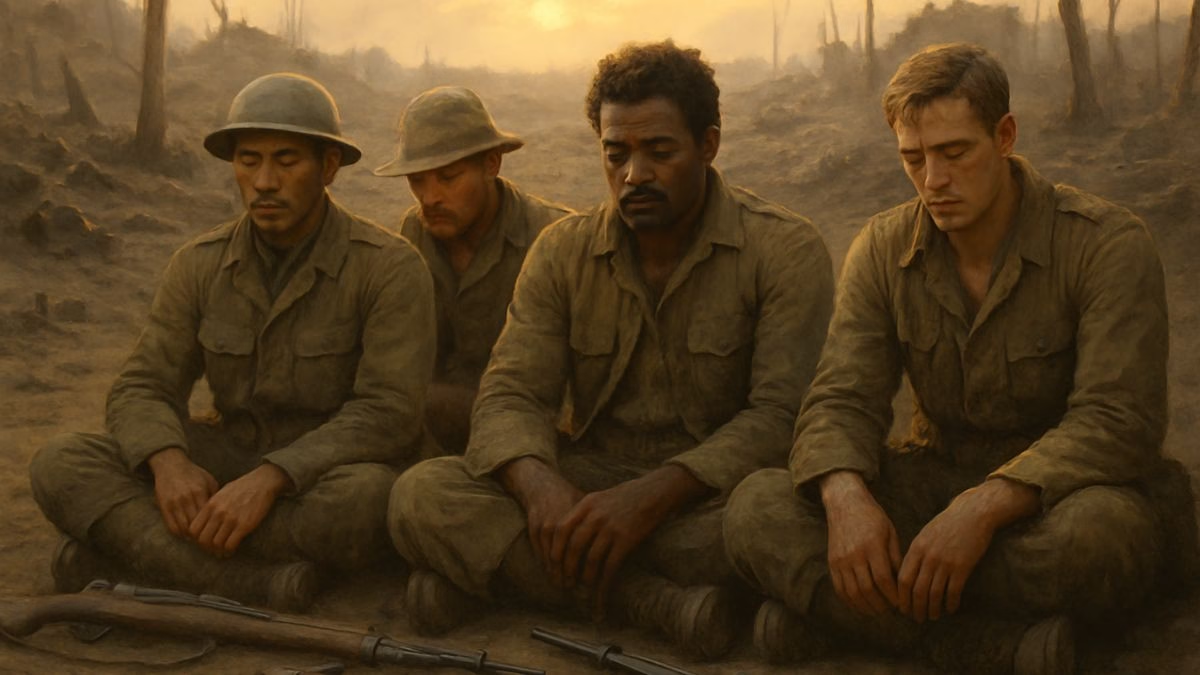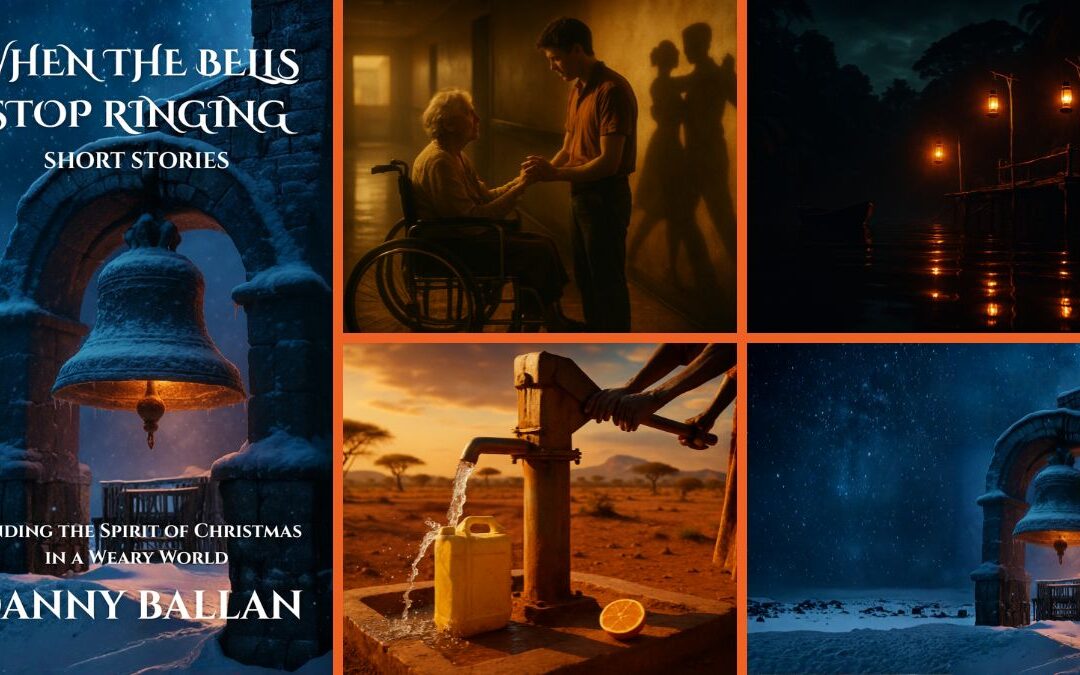- Audio Article
- When Guns Went Silent — Rare and Unexpected Moments of Peace
- The Candle in the Trenches — The Christmas Truce of 1914
- The Grammar of Mercy — Ad Hoc Burial Truces
- The Live-and-Let-Live Arrangement — Quiet Deals at the Front
- Vaccines Over Bullets — Ceasefires for Health
- A Holiday at War — Religious and Cultural Ceasefires
- The Corridor — Humanitarian Passages and Evacuations
- Rivalry Without Rivals — Sporting Pauses and the Spirit of Play
- When Civilians Lead — The Quiet Pressure of Local Peace
- The Ethics of a Pause — What Silence Can and Cannot Do
- From Pause to Policy — Turning Moments into Movements
- The Memory of Quiet — Why These Stories Endure
- MagTalk Discussion
- Focus on Language
- Vocabulary Quiz
- The Debate
- Let’s Discuss
- Learn with AI
- Let’s Play & Learn
Audio Article
When Guns Went Silent — Rare and Unexpected Moments of Peace
War is loud by design. It blasts orders through megaphones, hurls metal at the horizon, and fills the air with a constant percussion that trains the body to flinch. Yet history keeps a secret drawer of quieter artifacts—moments when the noise fell out of the sky and something almost domestic took its place. Not victory, not surrender; not even agreement, really—just a pause, a held breath, a brief decision to be human before returning to the script. These episodes don’t fit comfortably in official narratives. They are too inconveniently tender. But they matter precisely because they reveal what force insists is impossible: that even in the machinery of conflict, a hand can reach for a hand.
The Candle in the Trenches — The Christmas Truce of 1914
Picture mud and wire and a winter that has beaten even the bravest into a private shiver. Then, one evening, against standing orders and every good reason, songs drift across the lines. Lanterns rise. A carol crosses the no man’s land where bodies usually do. Men laugh at the absurdity, and then—God help their commanding officers—they stand up. Hands go up, too, not as targets but as greetings. Cigarettes and biscuits appear, the holding currency of goodwill among the exhausted. Someone produces a football; clumsy boots turn the killing field into a rough playground, and the most incredible stat of the day is nil-nil. By morning, generals have reasserted reality, but the soldiers have already learned what the official histories often bury: for a night, the front traded fear for fellowship. The war resumed, of course—it always does—but the memory survived like a contraband photograph carried in a breast pocket.
The Grammar of Mercy — Ad Hoc Burial Truces
In several campaigns, enemies agreed to temporary halts to gather their dead. The task was grim and intimate, a labor that required proximity and humility. You don’t look into the face of someone your shells killed and come away untouched. The odd courtesy appeared: water passed, a nod, even a shared complaint about heat or flies. These brief rituals exposed the lie that the other side is an abstraction. They also taught a durable lesson in the politics of pause: that a ceasefire can be both tactical and moral, and that humanity sometimes smuggles itself into policy through the side door of necessity.
The Live-and-Let-Live Arrangement — Quiet Deals at the Front
Not all peace is announced by trumpets. In prolonged trench warfare, a hush frequently evolved from mutual exhaustion. Officers issued orders; the ground issued limits. Snipers learned to avoid mealtimes; artillery crews aimed away from latrines. The conduct wasn’t codified, but it was understood: a microclimate of restraint that reduced daily slaughter without threatening the larger war. These arrangements were fragile and often broken by a new unit or an ambitious superior, yet they record something rarely captured by maps: the common sense of survival can be contagious.
Vaccines Over Bullets — Ceasefires for Health
Some of the most moving pauses in modern wars have been secured not by diplomats but by doctors and midwives. Public-health “days of tranquility” have allowed polio drops to reach small mouths and measles shots to journey along roads that normally belong to armed men. War grudgingly steps aside for the nursery schedule. These temporary corridors are logistical puzzles and moral declarations: children deserve the unmolested passage of care. Years later, when headlines forget the dates and acronyms, a scar-free arm in a schoolyard tells the story better than any communique.
A Holiday at War — Religious and Cultural Ceasefires
In conflicts where religion is a thread in the fabric, holy days sometimes pull both sides toward restraint. The logic is pragmatic (no one wants the optics of desecration), but the result is often sincere. Pilgrims arrive, families gather, and the combatants taste the ordinary again: bread, laughter, the delicate choreography of a blessing. The day after, the rifles may well resume their case against the future, but the pause changes the memory of time—proving that even a war can keep a calendar.
The Corridor — Humanitarian Passages and Evacuations
The word “corridor” should belong to schools and hospitals, yet in war it becomes sacred architecture. Humanitarian corridors carve a temporary hallway through chaos so ambulances can pass, so the elderly can ride out in the back of a bus, so a mother can carry a baby and a bag and nothing else. These are negotiated miracles. They collapse if one checkpoint panics or one commander misreads a line. But when they hold, they turn theory into life: the line between enemy and neighbor can be redrawn for an afternoon.
Rivalry Without Rivals — Sporting Pauses and the Spirit of Play
The ancient idea of an athletic pause—competitions declared safe harbors—still haunts the modern world. Sometimes it’s symbolic; sometimes it briefly lifts the weight of siege. Athletes from opposing sides share a lane, a pitch, a podium. The world watches, and for a few hours cheered excellence defeats cheered injury. Does a match end a war? No. But an image of rivals shaking hands can reroute a conversation at a dinner table otherwise colonized by rage.
When Civilians Lead — The Quiet Pressure of Local Peace
Grand treaties are written in capitals, but many of the most effective pauses are negotiated in villages and neighborhoods. A market needs to open. A harvest window won’t wait. A hospital’s generator is down to its last dribble of fuel. Clergy, teachers, neighborhood elders—people whose authority draws from trust rather than rank—broker a halt. These truces are rarely reported; they are too small for the international stage and too decent for propaganda. Yet they are the daily bread of survival and the living proof that peace is not only a treaty; it is a habit.
The Ethics of a Pause — What Silence Can and Cannot Do
Let’s not romanticize the hush. A pause is not justice, and a ceasefire without a plan is a sandcastle. Pauses can be exploited; they can mask rearmament or lull a community into false security. But to dismiss them is to misunderstand how change enters history: not just through decisive victories, but through incremental repairs. The soldier who traded coffee for a cigarette in the dark may carry that memory like a stitch in a wound. The medic who walked a corridor once may insist on one again. Peace is built by such insistences repeated.
From Pause to Policy — Turning Moments into Movements
The hard problem is converting moral interludes into political architecture. That requires three moves. First, archive the story before it evaporates—document the who, where, and how, so future negotiators can point to precedent. Second, scale what’s local: bake the logic of the truce into municipal routines—market days, clinic hours, school runs—so violations cost political capital. Third, create dignity pathways for the men with guns: demobilization that includes jobs, training, and some form of recognition that they were not only instruments of harm but also citizens with a future. Pauses are potent precisely because they model a different normal. Good policy translates the model into law and budget.
The Memory of Quiet — Why These Stories Endure
Why do stories of footballs kicked in mud and nurses waving ambulances through barricades endure long after strategic maps fade? Because they restore proportion. War tries to make itself the whole story; these moments remind us that it is only a very loud chapter. The rest of the book—families, work, seasons, the slow art of building a home—waits just offstage. When guns go silent, even briefly, the stage directions for that larger play return to view.
MagTalk Discussion
Focus on Language
Vocabulary and Speaking
Language is a kind of ceasefire in itself; it lets us negotiate meanings without throwing anything heavier than a metaphor. The article above is thick with phrases you can lift and carry into ordinary life. Start with “break through,” as in humanity breaking through the fog of war. This works outside conflict, too: a shy student can break through in class, a team can break through a stalemate, and you can break through a creative block by changing your routine. The phrase suggests effort rewarded by a sudden clarity—use it when the before-and-after is felt, not just measured.
“Hold your fire” lives in military registers, but it’s beautifully domestic. When you want to respond to a text immediately or slam a reply-all with a righteous paragraph, you can tell yourself to hold your fire—delay the response, cool the temperature, buy wisdom a few minutes to arrive. The power of the phrase is that it reframes restraint as action rather than passivity; you are doing something on purpose by not doing the impulsive thing.
“Against the odds” is a compact way to honor difficulty without dramatics. A bakery launched during a recession; a student learned to read in a second language while working nights; a startup built a prototype with pocket money. Say “against the odds” and you tip your hat to adversity without turning the person into a hero movie. It’s admiration at room temperature.
“Call a truce” travels well into households and offices. Two siblings can call a truce over a controller; two colleagues can call a truce on a debate that’s now generating more heat than light. It doesn’t mean surrender; it means we agree to stop scoring points and start solving the problem. The phrase is especially useful when a disagreement has become ritualized—when each side knows their lines too well and the conversation could continue forever in loops.
“Set aside” is another unassuming gem. To set aside anger is not to deny it; it’s to store it safely while you tackle what can be tackled. You can set aside your phone to reclaim attention, set aside judgment to listen, set aside budget for emergencies. The phrase builds shelves in your day; it’s tidy and respectful of priorities.
“Come to a halt” communicates a decisive stop with a hint of narrative drama. A project can come to a halt when a supplier disappears; a dinner plan can come to a halt when the gas runs out; a thought can come to a halt mid-sentence when a new fact lands. Compared to “stop,” it highlights the motion that preceded the stop, and that’s sometimes the point—the suddenness matters.
“Stand one’s ground” can be poisoned by swagger, but used well it’s about principled boundaries. If a meeting is scheduled across your child’s school performance and you say no, you’re standing your ground. If a friend mocks your dietary choice and you calmly persist, you’re standing your ground without turning the table into a courtroom. The phrase gains grace when paired with a reason that invites respect, not a posture that invites escalation.
“Relent” is the sound of a heart changing its mind. Weather relents, pressure relents, a parent relents and allows a later curfew. To relent is not to lose; it’s to decide that mercy or practicality has a better claim. Try saying “I can relent on the deadline if we trim the scope”—notice how it transforms the negotiation from tug-of-war to problem-solving.
“Fragile” is often misused as an insult, but it’s actually a design instruction. A fragile peace needs reinforcement; a fragile schedule needs padding; a fragile mood needs gentleness. When you call something fragile, you’re not announcing weakness so much as advising care. That’s leadership disguised as vocabulary.
“Ripple” is a favorite because it sneaks physics into feelings. A kind word ripples through a team; a bad policy ripples through a city; a small donation ripples through a clinic with outsized relief. The image helps you talk about consequences in living systems—one pebble, many rings. It’s a good antidote to the lie that small acts don’t matter.
How do you bring these into speech without sounding like you swallowed a seminar? Build a two-minute story. Start with a concrete scene—a decision at work or at home. “We were about to reply-all in a frenzy, and then we held our fire.” Immediately, the temperature drops. “The argument had come to a halt anyway; we were repeating ourselves.” That line signals self-awareness rather than blame. Then give credit to a pivot: “We called a truce and set aside the issue until after the client demo.” You’ve framed delay as discipline. Close with the consequence: “Against the odds, the presentation went smoothly, and the small courtesy rippled across the week.” You’ve tied cause to effect with an image that sticks.
Try this speaking workout: record a 90-second update about a plan that changed. Use eight of the phrases above. In the first twenty seconds, describe the problem and name what came to a halt. In the next forty, narrate the truce you called, the point where you stood your ground, and where you chose to relent. In the last thirty, show the ripple—what improved as a result. Listen back for three things: Do your verbs carry the weight? Are your sentences varied in length, with one good long sentence that rolls like a calm wave and one short sentence that lands like a period? Do you sound measured rather than theatrical? Repeat until your phrasing feels like one of those humanitarian corridors: a clear path through a crowded situation.
Grammar and Writing
Let’s anchor a writing challenge to the theme: craft a 900–1,100-word narrative essay titled “The Day the Street Forgot the War.” Your narrator—fictional or drawn from reportage—watches an unexpected pause unfold: a local ceasefire to evacuate a hospital, a holiday truce that lets a market reopen, or a quiet arrangement between patrols so children can take exams. The goal is to show, not announce, the pause’s texture: the sounds that replace gunfire, the choreography of help, the aftertaste of fear returning as the quiet ends.
Structure the arc in four movements:
- Approach: Use the past progressive to paint motion (“Vendors were lifting their shutters,” “Soldiers were loosening straps”) while the simple past drops headlines into the frame (“Then the siren stopped”). This tense pairing keeps the scene kinetic while marking the hinge that changes everything.
- Threshold: Deploy concessive clauses to code complexity: “Although no papers were signed, the checkpoint waved us through.” Concessives are your legal counsel; they admit to the record what might otherwise be challenged.
- Exchange: Bring dialogue in, but compress it with reported speech and appositives: “The nurse, a woman with hands that shook only after, told me they had one hour.” Appositives let you tuck character into the sentence without stopping the narrative to describe.
- Return: Let the present tense intrude near the end. One paragraph in present tense can deliver the feeling of memory that refuses to stay in the past: “Sometimes at night, the city remembers how to be quiet like that.” Then step back to past tense for the final cadence.
Now the grammar levers:
Participial phrases sharpen cause and sequence: “Lowering his rifle, the guard reveals he is twenty and terrified.” The opener condenses motive into posture. Beware the dangling modifier; make sure the phrase’s subject is the sentence’s subject.
Relative clauses provide specificity without a footnote: “Children, who had learned to count shells by sound, reached for bread with both hands.” The clause gives the reader the weight of lived expertise.
Parallelism turns description into memory: “The market smelled of oranges, diesel, and laundry soap.” Triplets stick. They also discipline you to choose concrete nouns over abstractions.
Hedging and stance (“largely,” “in part,” “likely,” “frankly”) keep you honest and human. In a context where certainty is a bully, a measured modal is courage: “The truce worked in part because the colonel’s daughter needed insulin.”
Rhythm is not decoration. Vary sentence length: one crisp five-word sentence can follow a long, rolling thirty-word observation like a bell after a choir. Reading aloud exposes the clumsy joints.
Punctuation as choreography: the colon promises an explanation (“We stopped: there was a child in the road”); the dash holds a sudden thought (“They stood together—awkward, as if caught borrowing time”); the semicolon links equal weights (“The trucks idled; the birds returned”).
Editing passes:
- Continuity: Track time like a medic tracks bandages. Are you accidentally making dawn last five pages? Place small clocks: “by noon,” “at the corner where the pharmacy once was,” “as the call to prayer thinned.” These anchor the reader in experience.
- Point of view: Choose a lens and stay faithful. A first-person narrator can know only what they see and hear; if you need wider context, use a frame at the start or end to grant it without breaking the spell.
- Verb audit: Replace state verbs (“was,” “were”) with action where possible. “The street was loud” yields to “Horns argued; a generator coughed.” Your prose starts breathing.
- Motive clarity: If a character relents, show the hinge. A line of dialogue, a glance at a photo tucked into a pocket, a radio message half-heard—give the reader a credible lever that moves a decision.
In the final paragraph, resist the temptation to sermonize. Let one image carry the thesis: a shared cigarette stub, a toy kicked from one soldier’s boot to a child’s hand, the sound a city makes when it remembers its other name.
Vocabulary Quiz
The Debate
Let’s Discuss
- What does a “useful pause” look like in a non-war setting—at work, at home, in politics? Explore how calling a truce, setting aside, or holding your fire can rescue projects and relationships without burying real issues.
- Are some pauses unethical? Consider ceasefires that are used to rearm, or silences that protect abusers. How do we distinguish healing quiet from manipulative quiet?
- Which institutions in your community function like humanitarian corridors—libraries, clinics, local markets—and how can we protect them during social “storms”?
- What small gestures ripple the farthest in tense environments? Share stories where food, music, or shared labor shifted a mood more than a speech did.
- How should these rare moments be remembered? Debate whether public memorials, school curricula, or local archives best preserve the memory of quiet courage.
Learn with AI
Disclaimer:
Because we believe in the importance of using AI and all other technological advances in our learning journey, we have decided to add a section called Learn with AI to add yet another perspective to our learning and see if we can learn a thing or two from AI. We mainly use Open AI, but sometimes we try other models as well. We asked AI to read what we said so far about this topic and tell us, as an expert, about other things or perspectives we might have missed and this is what we got in response.
Let’s widen the field of view. Three under-discussed dynamics shape why pauses appear and how they harden into norms.
First, supply chains of mercy. A corridor opens because fuel, drivers, medics, and negotiators line up on time. These are systems, not miracles. Where logistics culture is strong—reliable ledgers, honest fixers, mechanics who can coax a dying generator back to life—pauses are more likely to hold. If you want more peace, invest in boring excellence: road maintenance, cold-chain storage, transparent procurement. It sounds technocratic; it is. It’s also how insulin beats ideology.
Second, ritual time versus operational time. Armies run on clocks; communities run on calendars. When ritual time—harvests, holidays, exams—asserts itself, it can outmuscle the schedule of patrols. Smart commanders read the calendar as closely as they read the terrain; smart mayors negotiate from the authority of ritual, not just municipal law. Those who ignore ritual time end up fighting the weather of the human spirit, and that weather is stubborn.
Third, dignity mechanics. Pauses last when no one loses face by keeping them. That means language that lets both sides claim credit without humiliation: “We stood down for the sake of the children,” “We honored the holiday,” “We respected the clinic.” The phrasing matters because it builds a habit you can repeat. If a pause always equals “defeat,” it will be rare; if a pause equals “honor,” it will be a tool.
One last note: archiving. Treat each pause like an engineering prototype. Who called it? How long did it hold? Which phrase unlocked the checkpoint? Store those details. Tomorrow’s negotiator will need them the way a builder needs measurements.
Let’s Play & Learn
Learning Quiz | Language of Ceasefire
Words can calm a conflict—or accidentally inflame it. In discussions about peace, precision matters: a “ceasefire” is not a “treaty,” “reconciliation” isn’t the same as “pardon,” and “amnesty” differs from “immunity.” This quiz helps you master the language of peacemaking so you can read the news more confidently, write clearly, and take part in nuanced conversations about conflict and harmony. You won’t just pick answers; you’ll learn through targeted hints and conversational feedback that explains why one term fits and another doesn’t. By the end, you’ll be able to distinguish temporary pauses from permanent settlements, legal forgiveness from personal healing, and diplomatic tools from humanitarian steps. In short, you’ll gain the vocabulary to talk about peace with clarity, empathy, and accuracy.
Learning Quiz Takeaways
Peace doesn’t arrive with one magic word. It arrives through a careful sequence of words whose meanings guide real choices: pause, talk, verify, heal, and rebuild. If you’ve worked through the quiz, you’ve seen how tiny differences in vocabulary carry big consequences for policy, law, and everyday understanding. Let’s pull the key insights together and turn them into a practical toolkit for reading, writing, and discussing peace-related issues with clarity.
Start with time. Words like ceasefire, truce, and armistice tell you where you are on the timeline of a conflict. A ceasefire is the pause button—immediate, practical, usually temporary. You’ll often see it tied to an urgent humanitarian need, such as evacuations or aid delivery. A truce is similar but usually even more specific and short-lived—think a 24- or 48-hour halt to retrieve the wounded or allow talks to start. An armistice steps further: it’s formal, written, and intended to end active fighting as a bridge to a settlement. When you read headlines, ask: Is this a brief truce to solve a local problem? A theater-wide cessation of hostilities to open negotiations? Or a formal armistice that stops the guns across the front? That time awareness prevents you from mistaking a pause for peace.
Now think about permanence and law. The word treaty should prompt you to expect legal obligations, ratification, and detailed terms governing borders, trade, security, and dispute resolution. Treaties are not just words on paper; they are frameworks that make future choices more predictable. If a report mentions a “framework agreement” or a “comprehensive peace agreement,” read for the scaffolding: implementation timelines, verification bodies, and mechanisms for resolving disputes. By contrast, a goodwill gesture—like releasing detainees or reopening a road—signals intentions but lacks the binding force of a treaty. Both matter: gestures build momentum; treaties lock it in.
Trust is the third pillar. Confidence-building measures are the small gears that make the big machine work. Sharing water resources, restoring phone lines, setting up hotlines, or allowing neutral observers at checkpoints—all of these reduce the risk of accidental escalation. When you hear “de-escalation,” think of specific moves that lower danger: pulling heavy weapons back, creating buffer zones, and establishing rules for patrols. The vocabulary here teaches modesty: peace grows through verifiable steps, not sweeping declarations alone.
The quiz also highlighted the human and legal dimensions. Amnesty and pardon are often confused, but they operate at different scales. An amnesty tends to be broad—aimed at a defined group with conditions, like surrendering weapons or telling the truth in a public process. A pardon is individual and can be granted for many reasons, from mercy to judicial error. Both can be controversial, which is why understanding their scope and purpose matters for public debate. Immunity, meanwhile, often involves exchanging protection from prosecution for cooperation or testimony—a different tool with different trade-offs.
Reconciliation and forgiveness deserve special care. Reconciliation is social and institutional: truth commissions, memorialization, reparations, curriculum changes, and reforms that acknowledge harm and rebuild trust. Forgiveness is personal, private, and never mandatory. Societies can move toward reconciliation even when not everyone forgives, because reconciliation is about establishing a workable, dignified future. When you see these words, look for the level: are we discussing community processes and policies, or individual emotions? Mixing them up can unintentionally burden victims or trivialize the societal work required.
Dispute resolution terms—mediation and arbitration—tell you how decisions are made. Mediation preserves agency; a mediator facilitates conversation and helps parties find their own agreement. Arbitration hands authority to a neutral decision-maker who issues a binding ruling. In a peace process, mediation is more common because it aims to build ownership of the outcome. Arbitration suits technical disputes or situations where parties prefer a faster, authoritative decision. The vocabulary signals the power dynamics at play and the likely durability of the solution.
Human safety terms give you clues about ethics and logistics. A humanitarian corridor enables safe movement for civilians or aid in dangerous areas. A ceasefire can enable corridors, but corridors can also exist under limited, localized arrangements even when broader fighting continues. A demilitarized zone is different: it’s a defined area where military presence is restricted or banned, often long-term and monitored by observers. These labels matter, because they set expectations for behavior, verification, and accountability.
Normalization and non-aggression pacify different parts of the relationship. To “normalize relations” is to reestablish diplomatic contact, reopen embassies, resume flights, and restart trade. It’s the practical glue that lets people live ordinary lives again. A non-aggression pact, by contrast, is a promise not to attack; it addresses fear directly but doesn’t create the day-to-day cooperation that makes peace resilient. Used together, they reduce both fear and friction.
The quiz also emphasized sequencing—the idea of a phased roadmap. Peace processes often stall when everything is demanded at once. Sequencing breaks complexity into steps: verifiable ceasefire, prisoner exchanges, humanitarian access, political talks, and, finally, a comprehensive settlement with implementation calendars. Each step builds confidence for the next. When you hear about a peace roadmap, look for milestones, verification, and consequences for non-compliance. If the language is vague, ask for specifics; precision stabilizes expectations.
Disarmament, demobilization, and reintegration are the mechanics of turning fighters back into neighbors. Disarmament reduces or eliminates weapons under monitoring. Demobilization formally releases combatants from armed service. Reintegration helps them return to community life with jobs, education, and support so the conflict’s human fuel does not reignite. These are not side issues—they are central to preventing relapse.
Finally, remember that words are signals and commitments. When diplomats invoke “good offices,” they are appealing to credibility. A respected state or organization can host, shuttle messages, and lend the process legitimacy. Without that legitimacy, parties may doubt each other’s intentions and the public may doubt the outcome. Language doesn’t just describe peace; it constructs it. Clear, shared definitions make it possible to coordinate actions across many actors with different interests.
So how do you use this vocabulary in everyday life? When reading an article, identify where the situation sits on three axes: time (temporary pause vs. permanent arrangement), law (symbolic step vs. binding deal), and trust (isolated gesture vs. verified system). Translate the headline into the process: “Ceasefire announced” means “pause achieved; now watch for corridors, verification, and talks.” “Armistice signed” means “fighting ended formally; now watch for treaty negotiations.” “Normalization agreement” signals “embassies, flights, trade—everyday life coming back.” This translation habit turns ambiguous headlines into understandable progress reports.
In writing, choose the precise term that matches your intent. If you mean a short pause, say truce or ceasefire; if you mean a formal end to fighting, say armistice; if you mean the legally binding settlement, say treaty or peace agreement. If you’re discussing social healing, say reconciliation and specify the mechanisms—truth-telling, memorials, reforms—so people know you’re talking about shared civic work, not private emotions.
Above all, let vocabulary be a tool for empathy. Using the right word respects the complexity of people’s experiences—victims, veterans, negotiators, and ordinary families. Peace is not just the absence of gunfire. It is the presence of trust, fairness, and workable routines. The language you now command points the way from one to the other: from pause to promise, from promise to practice, and from practice to a peace that people can actually live in.










0 Comments